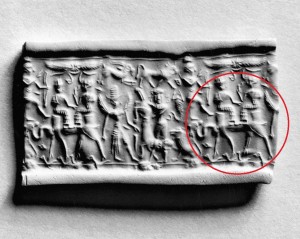4- Anachronisms—inconsistent dates, events, or features of a text. An anachronism is a feature of a text that doesn’t fit the claimed or perceived date of an ancient text. A simple example of an anachronism would be if a text described Jesus taking an airplane from Nazareth to Jerusalem. Most anachronisms, however, are much more subtle than this. For example, medieval art consistently depicts soldiers in biblical stories using medieval arms and armor. Although this is anachronistic, it does not demonstrate that the biblical stories themselves are anachronistic, only that the medieval artistic interpretation of biblical stories is anachronistic. Thus, what may seem like an anachronism to modern readers may not have actually been an anachronism. That is, we may be in error in believing that a particular feature is anachronistic because of either lack of knowledge, or misunderstanding. This distinction between an internal anachronism that is integral to a text and an interpretative anachronism perceived or created by a particular interpreter is important to bare in mind when trying to understand the Documentary Hypothesis. We should also note that editing an redacting a text can introduce editorial anachronisms—the date of the original composition of a text needs to be distinguished from the date of the final editing of the text.

An example of a perceived anachronism is the claim that the camel was not domesticated at the time of Abraham. A recent study by Israeli archaeologists of the earliest camel bones discovered in Israel found that they date to the ninth century BC. Some people claim that this demonstrates that camels were not domesticated before this time, and therefore the appearance of camels in the story of Abraham (Gen. 24) is anachronistic. First, what the archaeological data is is that the camel was definitely domesticated by the ninth century; it is not proof that the camel was not domesticated earlier. Second, it needs to be noted that most surviving animal bones discovered by archaeologists come from garbage dumps at sites of human cooking or sacrifice. The camel was not sacrificed by Israelites, nor was it eaten because it was considered unclean (Lev. 11:4). This means that camel bones are much less likely to be discovered in Israelite archaeological sites. Finally, there is artistic evidence of the domestication and riding of camels by at least the eighteenth century BC (see illustration). Even if no camel bones have been found in archaeological sites in Israel before the ninth century BC, it is nonetheless clear that the camel was domesticated in the region much earlier. Thus, the mention of camels in Abraham represents a perceived anachronism, but not necessarily an integral anachronism.
We need to remember that the historical principle of anachronisms works both ways. That is to say, something in a text can be anachronistic is if it is too late for a proposed date for a text, but also if it is too early for a proposed date of a text. Anachronisms that seem to be older than a proposed date for a text are often called archaisms.
Documentarians often posit that chronological data, specific dates, or historical allusions in a text do not necessarily reflect the original date of the text, but could have been inserted at a later date in the process of editing and redaction. As many scholars have noticed, this creates a major methodological problem for the Documentary Hypothesis. Because it posits later redactors and editors who changed the text throughout its transmission, it renders the dating of biblical texts very difficult, if not nearly impossible. We can never be certain if a chronological characteristic is original, mistaken, or represents a later editorial change or addition. Thus, as we shall see, even though they are using precisely the same methodology, some Documentarians date the Yahwist/J source to the tenth century BC, while others date the Yahwist to the sixth century BC—a range of nearly half a millennium. This significant issue will be discussed in more detail later.
Finally, we should note that there is a significant difference between dating a manuscript (the date of the writing of a particular physical piece of parchment, papyrus or paper), and the dating of a text (the original date of the composition of the words on a parchment). Thus, the date of the composition of the Book of Ezekiel is the sixth century BC, while the date of the oldest surviving physical manuscript fragments of Ezekiel is the second or first century BC in the Dead Sea Scrolls—nearly half a millennium after the original composition of the text.











